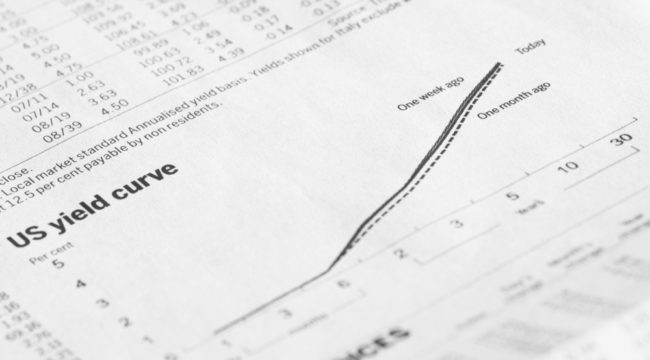What the "Yield Curve" Predicts for the Economy
Two conflicting visions of the economy. One good. One bad.
Which is right? Which is wrong?
Today we follow the cut and thrust of debate… weigh evidence… and cast a wry squint into the future…
Says litigant No. 1:
The U.S. economy has posted consecutive quarters of 3% real GDP growth — the swellest two-quarter average since 2014.
Housing starts jumped 13.7% last month, beating even the brightest forecast.
Housing permits — an even truer barometer of the housing market — increased a thumping 5.9%.
Manufacturing also increased 1.3% last month… in full defiance of “expert consensus.”
More good news:
Official unemployment plumbs its lowest depths in nearly two decades — 4.1%.
The future is a rosy dawn place, this fellow concludes.
But litigant No. 2 draws a cloud across this sunshine by introducing an unimpeachable witness to the proceedings:
The bond market.
If the economy gives off such a glow, asks he… why is it not reflected in the bond market?
Longer-term bond yields should rise in anticipation of higher growth… higher inflation… higher animal spirits.
But at 2.37%, the yield on the bellwether 10-year Treasury is not only lower than a year ago… but lower than a month ago.
Therefore, argues this fellow, Pollyanna’s case wobbles on its axis.
The data are a distortion, a fleeting mirage.
He then summons another creature of the bond market — a possible omen of recession — to advance his bearish case:
A flattening yield curve.
Since December 2015 the Federal Reserve has been increasing the interest rates it influences directly — short-term rates.
Its current target rate sits between 1% and 1.25%.
Markets also forecast a 91% chance of another 0.25% rate hike when the Fed meets next month.
Many analysts expect three or four hikes next year.
But the small short-term hikes have failed to fluster the bigger fish — both 10-year and 30-year Treasury yields have declined this year.
That means short-term rates and long-term rates are converging… or flattening.
Why the big deal?
Because most consider a flattening yield curve an omen of lean times ahead.
Bob Johnson, director of economic analysis at Morningstar:
A flatter yield curve is viewed as a sign of upcoming weakness… If long-term and short-term rates are close, markets must be expecting little growth…
And despite the recent positive economic data and all the angels and saints… the yield curve is flattening.
Something isn’t right.
Tad Rivelle of global asset management firm TCW:
Stocks roar to new highs. Tax cuts advance in Congress, I think. Consumer confidence revs while unemployment plumbs its lowest levels in decades. Yet the yield curve just doesn’t seem to be buying it.
BMO Capital Markets strategists Ian Lyngen and Aaron Kohli also scratch their heads:
Growth is moving at a solid clip and the labor market is ostensibly at full employment — so why aren’t we in an environment with a steeper curve and higher yields?
The world wonders.
But is a flattening yield curve an immediate menace, a storm cloud overhead?
Not necessarily, say the experts. Not yet.
Bloomberg’s Tim Duy:
The yield curve was extremely flat during the second half of the 1990s, a stretch of high growth. Only late in that period did the yield curve invert, finally foreshadowing the 2000 recession.
Here Duy points out the true bugaboo — the inverted yield curve — when short-term rates actually overtake long-term rates.
According to Bank of America, an inverted yield curve has preceded recession on seven out of seven occasions over the past 50 years.
Not a record to be sniffed at.
The yield curve last inverted in early 2006. The economy was sunk in recession less than two years later.
It previously inverted in 2000… before that year’s recession.
When might the yield curve invert again?
Conor Sen, also of Bloomberg:
With the Fed likely to raise interest rates in December, and then perhaps another three or four increases in 2018, the yield curve could invert this time around as soon as the second half of next year.
Lacy Hunt, chief economist at Hoisington Investment Management, also believes the curve could invert within a year — if the Fed tightens as planned.
So here is the larger lesson of the flattening yield curve…
The Federal Reserve cannot continue raising short-term rates so long as long-term rates fail to respond.
Otherwise it could invert the yield curve… and, if history is a reliable witness, court recession.
So unless long-term interest rates begin to rise along with short-term rates, the Fed is trapped.
And it will have little “dry powder” to combat the next recession — whenever it comes.
So… are you sure you want that job, Mr. Powell?
Regards,
Brian Maher
Managing editor, The Daily Reckoning



Comments: